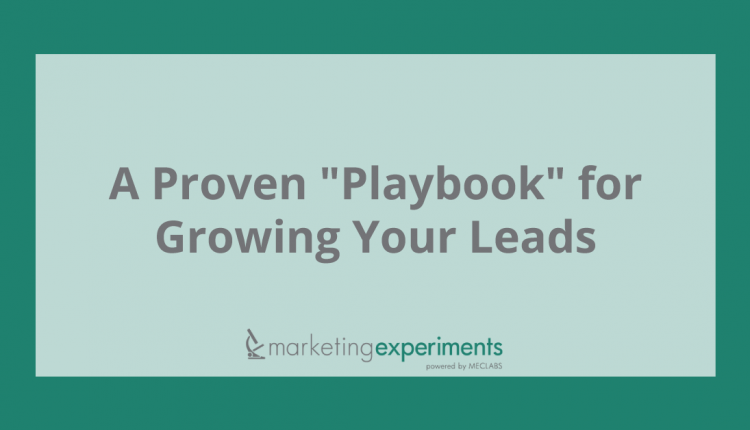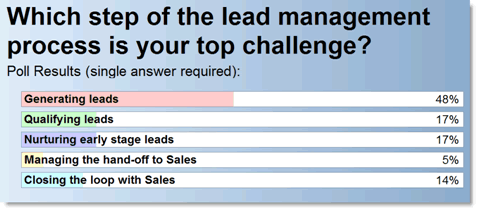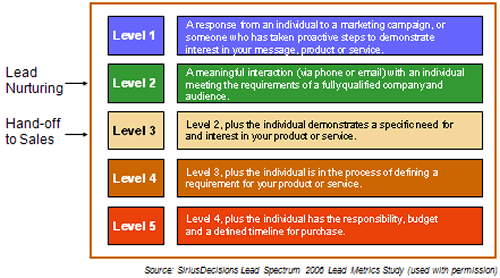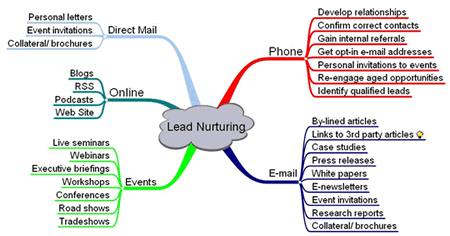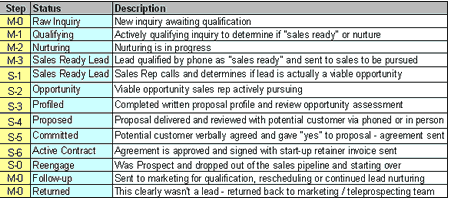Ever wonder if you’re approaching lead generation the wrong way?
You may be right. Research shows roughly 80% of leads are regularly squandered.
Good news: By optimizing a few key aspects of your lead management process, you can achieve major ROI gains in a short time (even in a shaky economy).
In our September 24, 2008 special guest web clinic, lead generation expert Brian Carroll and Dr. Flint McGlaughlin explored strategies to dramatically increase your B2B leads pipeline and conversion rate.
Carroll presented his proven five-step “playbook” for effective lead management, along with a powerful case study from a partner that applied the playbook and achieved gains of up to 375%.
Where Lead Management Efforts Go Wrong
Why do so many organizations struggle with the lead generation process?
We asked our web clinic participants to identify which step of the lead management process is their top challenge. Of the 594 responses, a combined 82% said generating, qualifying or nurturing leads. The remaining 18% chose the processes involving Sales.
Many of these problems stem from perception and communication issues between Marketing and Sales. In particular, the often confusing definition of what constitutes a genuine “sales ready” lead.
Getting both departments on the same page is the foundation for optimizing the lead generation process. What’s often overlooked is that generating more leads, even high quality leads, is not the answer by itself. Marketing and Sales need to use qualification and nurturing to optimize the leads that are already in the pipeline.
The lead nurturing process also suffers from perception and communication issues, not only between marketers and salespeople, but with prospects and customers. Doing business today isn’t just about hitting targets and sales goals; it’s about people. In turn, nurturing is really about building trust and relationships, especially where complex sales are concerned. Don’t you think customers can tell the difference?
Let’s look at how optimizing these processes can produce major ROI gains.
[Editor’s Note: The following case study is provided by Brian Carroll, CEO of InTouch, a division of MECLABS Group, and is drawn from lead management services provided by InTouch.]
Case Study: Rescuing Leads from a “Black Hole”
We partnered with a mid-sized technology services company to help stop the loss of leads and sales opportunities.
With $80 million in annual revenue, and a team of 27 salespeople and 10 marketers, the company had a strong foundation, yet it faced several familiar lead management issues.
The amount of leads was growing rapidly, but conversions to sales were not increasing at a similar pace. Marketing felt that the leads passed on to Sales disappeared into a “black hole.” The lead-to-sale pipeline conversion rate was less than two percent. Salespeople often provided little or no feedback on leads.
All these factors contributed to a situation where the company was unable to consistently measure ROI from lead generation efforts.
Applying the lead management “playbook”
We used our lead management “playbook” as a tool to identify, evaluate, and address the underlying issues, including:
- Marketing’s effectiveness was being hampered by a lack of consensus on a universal definition of a qualified lead.
- Promising leads were disappearing because they weren’t qualified and prioritized, while early stage leads weren’t being nurtured into viable sales opportunities.
- The lack of consensus and follow through meant that the sales team didn’t pursue the majority of leads.
- Because there was no clear hand-off process or accountability connecting the sales and marketing teams, communication between the two had deteriorated.
The playbook below outlines the actions we took to rectify these problems – and the results they helped our partner achieve.
Lead Management Playbook: Five Key Steps
These five steps are the foundation of our closed-loop lead management system:
- Refine universal lead definition of “sales ready”
- Qualify leads based on universal lead definition
- Nurture early leads until “sales ready”
- Define hand-off process from Marketing to Sales
- Close the loop via Sales and Marketing “huddle”
To understand the process of moving from effective thinking about leads to effective implementation, let’s examine the essential elements of each step.
Step One: Refine the Universal Definition of a Lead
If you’re trying to measure lead generation without a universal lead definition (ULD), you’re simply not capitalizing on all your opportunities. A universal lead definition can be a valuable aid to clarify the qualification status of new leads. The more qualification information you can provide salespeople, the more you’ll be able to increase your sales pursuit rate.
Marketers need to combat poor lead management at the beginning of the cycle by focusing on increased communication between sales and marketing to:
- Jointly establish the definition of a qualified lead, and
- Clarify accountability and the process for nurturing qualified leads.
What is a Lead Anyway?
As Carroll writes in Lead Generation for the Complex Sale, “If you have eight hours to cut down a tree, spend six hours sharpening your axe.” In other words, at the beginning of your lead definition process, allocate time for Marketing and Sales to develop a consensus vision of what, exactly, connotes a qualified lead for your organization.
Once that definition is established, leads can be qualified and prioritized according to their readiness for the sales team.
Essential Criteria of Lead Definition:
While the definition of a “sales ready” lead will vary by organization, having a ULD will:
- Develop the profile of the ideal customer to pinpoint qualified leads, and
- Help identify the best possible opportunities rather than those that are fastest to close.
It doesn’t matter if you call your leads Levels 1-5 or Blue, Green, and Red, so long as the names have a clear significance that galvanizes your team.
Suggested Spectrum of Lead Definition:
How We Applied Step One
In the case of this partner, we worked with the sales and marketing teams to develop a ULD based on criteria such as:
- Spoke with a decision maker
- Meets our ideal customer profile
- Clear business need for what we sell
- Plans to evaluate in three months or less
- Purchase decision in six months or less
- Ready to speak with sales rep within two weeks
- Gathered information fits our target profile
- More than 1,000 desktop systems
- Current solution in place and satisfaction
- Number of mobile users, company size, number of locations
Leads that fit these criteria were considered “sales ready” leads, while those that did not were held back for additional nurturing.
Step Two: Qualify Your Leads
Once you’ve developed your ULD, it’s crucial to make that language and those concepts the central part of your lead qualification process.
Leads qualified against a ULD have a higher lead-to-opportunity conversion rate, that is, they are more likely to be considered true sales opportunities than leads based solely on an inquiry or form submission.
Qualification with ULD allows you to practice the art of “less is more.”
Through qualification, you consolidate and centralize inquiry information so your team can see where more knowledge is needed.
Qualification using a ULD allows you to:
- Pick up the phone and qualify prospective leads
- Determine a clear hand-off procedure for every lead
- Measure sales pursuit on every lead
One significant part of lead qualification is its potential to help you identify “early leads,” clients with whom you need to develop a relationship, and “slow-growing” leads, clients whose needs or awareness of their needs don’t yet match your services but, in time, could be an ideal fit.
How We Applied Step Two
As our partner began using a ULD to qualify leads, the company’s lead-to-sales pipeline and opportunity rate soared, as shown in the following chart.
| Partner’s Lead to Sales Pipeline Rate | Opportunity Rate |
|---|---|
| Before: No lead qualification or ULD |
4%
|
| After: Lead qualification with ULD |
12%
|
| Relative Difference: |
200%
|
What you need to understand: Leads qualified against a ULD had a 200% higher lead-to-opportunity conversion rate.
Its important to remember that the lead definition process is iterative. It’s not a one-time thing, so marketing and sales teams need to revisit the definition, keep asking questions, and make adjustments as needed.
Step Three: Nurture Early Leads Until They Are “Sales Ready”
While most salespeople need to focus on qualified leads, marketers and sales should also broaden their lead management process to incorporate nurturing early-stage leads. What exactly is lead nurturing?
Lead nurturing is creating a relevant, consistent dialog with viable potential customers, regardless of their timing to buy.
Because adhering to a ULD encourages consolidating information about your leads, companies can approach relationship building with a lower risk of redundant touches (email, phone, etc.) that would undercut sales and the company’s brand image.
With that in mind, using a “multi-modal” approach to nurturing is essential to organizing and filtering the content of your interactions. Here’s an illustration that shows the many channels used for lead nurturing:
Although there are a variety of tools and approaches that help with nurturing leads, there is a fundamental principle that can be easily forgotten in the pressure to hit sales goals.
Nurturing involves both individuals and organizations. In a complex sale, end-users and even decision makers are not the only players. Any number of different influencers might be involved in the ultimate purchase decision, so it’s not unusual for early-stage leads to require three or more touches to become sales ready.
Bottom line: The largest database is rarely the most productive or profitable one. Rather, it is the nurtured database that contains relevant, active contacts developed through time and trust – and that allows a company to stay ahead of its sales cycle instead of scrambling to meet monthly or quarterly targets.
How We Applied Step Three
When our partner implemented a lead nurturing process, and began passing along only the “sales ready” leads, the sales-to-pipeline rate improved swiftly and dramatically.
| Early Stage Leads Converted to “Sales Ready” Leads | Monthly Lead Vol. |
|---|---|
| Before: No lead nurturing (1 touch) |
16
|
| After: With nurturing (3+ touches) |
76
|
| Relative Difference: |
375%
|
What you need to understand: Holding leads back and nurturing them with relevant communication and multiple touches increased conversion to sales ready leads by 375% in the first eight months.
Step Four: Define the Hand-off from Marketing to Sales
Lead-to-opportunity conversion rate is one of your most important metrics. It helps you understand how well your sales team accepts and pursues leads, and ultimately shows if your leads are truly helping your sales force sell – and how much of a positive contribution you are making to their pipeline.
An effective hand-off from marketing to sales is more than simply passing along a lead. It actually entails three stages:
- Marketing must provide Sales with enough information that sales can act effectively.
- Both Marketing and Sales must agree on a transfer of ownership of the lead.
- Marketing and Sales must establish a definite method and time to receive feedback on leads.
Questions that will help you ensure that your leads are sales ready:
- Do they fit in your Universal Lead Definition?
- Did they confirm that they want to speak with a sales rep?
- Do you have the qualification information?
To confirm that the leads you’re handing off are sales ready, set firm deadlines for salespeople to provide feedback, such as within 24 hours. Also, document the hand-off process so you can measure the lead-to-opportunity conversion rate (see example below).
Sample lead tracking sheet
In the example above, two of the most important steps in the process are M-3 (Sales Ready Lead) and S-2 (Opportunity). Lead-to-opportunity conversion rate is one of the most important closed loop metrics you can measure.
Step Five: Close the Loop with Marketing and Sales
Getting live feedback on leads from salespeople is vital to making sure they are acting on leads. It also yields better lead refinement.
For closed-loop feedback huddles to be effective, they must be structured around the open discussion of all attendees. Initial meetings can encourage communication by asking sales and marketing teams to respond to a few prepared questions, such as:
- Have you been satisfied with the quantity of leads that has been generated?
- Is there anything unique about the leads that went into the sales pipeline or were closed?
- Do database notes contain enough information to prepare for the next steps?
- What other questions would help us better prepare for the next action?
Other elements that should be incorporated into huddles include:
- Timing – Huddles should be consistently held, at least once a month. With our partner, we started with a weekly huddle to get the system rolling, and then shifted to biweekly as the system took root.
- Status – Where are the leads currently in the sales process? Which leads have been incorrectly qualified and need further follow-up? Which leads need to be handed back to Marketing for additional nurturing?
- Review – What’s working with the current process? What still needs to be improved? What wins can be celebrated with both teams?
Feedback huddles can meet with resistance from team members and be a challenge to organize or facilitate. However, the reward for this extra effort is improvements in all aspects of the sales and marketing partnership, as well as greater results.
Pulling It All Together: The ROI Impact of the Playbook
After working with our partner to implement the five strategies outlined above, in only eight months’ time, the results were remarkable.
Based on the partner’s average figures:
- Average sale: $100,000
- Cost per opportunity: $4,611
- Cost per sales ready lead: $665
Plus the improvements from the playbook approach:
- 375% growth in sales ready leads
- 200% growth in lead-to-sale pipeline rate
The end result was:
$4.9 million in additional sales pipeline growth in 8 months
Having a clear ULD is one of the most critical factors for tracking ROI. Simply put, if you are not using a ULD, you are using skewed numbers.
Another key to measuring ROI is using cost-per-opportunity. This is a much more valuable ROI indicator than cost-per-lead because it tracks viable sales opportunities – not just leads that drive more activity. If you are just measuring cost-per-lead and not cost-per-opportunity, you won’t know whether or not your leads are actually helping your sales team sell more.
Points to help you optimize your lead management process and achieve major ROI gains:
- To capitalize on more opportunities, you must establish a universal lead definition (ULD) and qualify leads against it.
- Lead nurturing is about maintaining a relevant, consistent dialog with viable potential customers, regardless of their timing to purchase.
- Lead-to-opportunity conversion rate is an important metric that shows how well the leads are contributing to sales.
- If you are not using a ULD for ROI tracking, your numbers are almost certainly skewed.
- Cost-per-opportunity is a more valuable ROI indicator than cost-per-lead because it tracks viable sales opportunities.
Related Marketing Experiments Reports
- Filling the Pipeline: How a LeadGen Test Strategy Achieved an 86% Increase in Conversion
- Lead Generation
- Increase Conversion
As part of our research, we have prepared a review of the best Internet
resources on this topic. Rating System
These sites were rated for usefulness and clarity, but alas, the rating
is purely subjective.
* = Decent | ** = Good | *** = Excellent | **** = Indispensable
- Closed Loop Feedback: The Missing Lead Generation Huddle ***
- Collaboration Huddles and 35 Other Ways to Improve Sales and Marketing Teamwork ***
- What’s a Lead? End the marketing/sales tug of war (and improve ROI) with a better lead qualification process ***
- How to Precisely Define a “Lead” Before Marketing Begins ***
- Sales Lead Generation ***
- Do You Know Qualified Business Leads When You See Them? ***
Credits:
Managing Editor — Hunter Boyle
Copy Editor — Frank Green
Contributor(s) — Brian Carroll
Flint McGlaughlin
Anna Jacobson
Bob Kemper
Production — Mel Harris
Austin McCraw
Cliff Rainer
Amanda Mehlhoff



